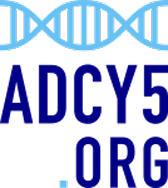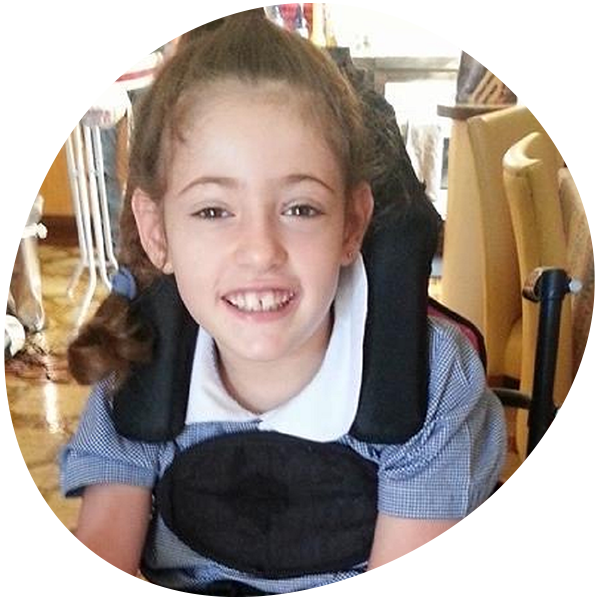Community
Laura’s Story
Hi! Can you start by sharing a little about yourself and your family?
My daughter Laura was diagnosed with ADCY5‐related movement disorder (ADCY5‐RMD) several years ago, and she is now 14. We live in Florida, where Laura enjoys ballet, gymnastics, cheering for her big brother at wrestling tournaments, and spending time with friends. Laura has an English Springer Spaniel named "Penny".
Can you tell us about the first symptoms you noticed? When did you first realize there might be something different or unusual?
Laura was an extremely fussy baby. Our doctors thought it was reflux, but she rarely slept and cried more than a typical baby. She met all of her milestones until 6 months, when she wasn't sitting up. I brought up the concern to her pediatrician, who referred Laura for a developmental evaluation, which found that she was very delayed in gross motor skills. I work in the medical field, so I contacted a geneticist who was able to see her within a couple days. He felt that she was hypotonic and began a full genetic and metabolic work up. At the time, that consisted of a Microarray, carnitine profile, amino acid profiles, organic acid profile and a MRI. All tests were normal. She was then diagnosed with Congenital Benign Hypotonia and we were told to keep following.
We first noted Laura's abnormal movements at about 11 months. She began to have sleep myoclonus. The neurologist admitted her for a 24 hour video EEG. There were no seizures and they placed her on Clonazepam at bedtime. This was life changing. With the Clonazepam, Laura was able to sleep. She still had the sleep myoclonus, but it was quite improved. Once she was able to sleep, she became a very happy child. No more screaming at all hours. She was still unable to sit up, but could mobilize herself by rolling on the floor. She wasn't able to talk, but was able to use simple sign language. Throughout all of this, Laura was getting almost daily therapies and was finally able to sit at 18 months. She never really crawled, but still preferred to roll. Her speech began to develop. Her movements began to change some over time. She continued to have sleep myoclonus, but sometimes she would have some choreiform and dystonic movements as well. Once again, they admitted her for video EEG. Although they could not identify seizures, they diagnosed her with epilepsy and Cerebral palsy. She was put on seizure medication. There were no improvements. The geneticist felt like it was more than likely an undiscovered genetic disorder and we would just need to be patient until medical science advanced enough to find an answer.
What was your journey to getting a diagnosis? What specialists or testing did you go through, and how long did it take to get the result?
We continued to search and talk to as many specialists as possible. A friend contacted us to let us know she had seen an episode of "Mystery Diagnosis", which featured a case that sounded similar to Laura’s, and after watching this episode about Dopa-Responsive Dystonia, we agreed. I was able to contact the doctors from the show and they actually referred us to a Neuro-Geneticist in Atlanta. It was very difficult to get an appointment, but once he saw Laura, he agreed to take her case. His lab had the latest equipment and he was able to run all tests that were available at that time (Laura was about 2.5-3 years old). The only abnormal test was from the fresh muscle biopsy. Although the mitochondrial DNA was normal, her mitochondrial function was decreased. He told us that the answer was more than likely in the nuclear DNA, but at this time, DNA sequencing was not commercially available, it was still being researched. Her new diagnosis was Mitochondrial dysfunction of unknown etiology. Once again, we had to be patient.
Laura began to take her first steps at about 3 years. Her movements were becoming worse. She had a lot of falls and injuries, but she continued to try. When Laura was 7, we were sitting at home when an episode of "The Doctors" came on. It was a show featuring the same family from the "Mystery Diagnosis" episode. They were telling their story of how they were now able to link the Dopa-Responsive Dystonia to a specific gene due to the newly available exome sequencing. This was being done at Baylor University in Texas, and I immediately emailed the doctor at Baylor and got an appointment for Laura. Once they saw her, they ordered whole exome sequencing. After a few months, they contacted us to let us know that they felt like the ADCY5 gene was responsible and that this was a spontaneous mutation. However, they said there had never been any reports of this, so they couldn't give us any information on what it really meant. We immediately began searching the internet. We were able to find a story in National Geographic, which was written about Lilly Grossman. I found the Grossmans on Facebook and contacted them. Lilly had been diagnosed a few months before Laura and we later found that there was one other person diagnosed around the same time. We were so grateful to finally have an answer and so very happy to be able to find someone else out there that knew what we were going through.
“We were so grateful to finally have an answer and so very happy to be able to find someone else out there that knew what we were going through.”
Describe how you live with ADCY5‐related movement disorder (ADCY5‐RMD) day-to-day: how is your routine similar or different to others? What are some ‘wins’ and ‘lows’ right now?
Laura's movements are now better controlled. She had DBS surgery when she was 9. This helped with her trunk control, balance and greatly improved the sleep myoclonus. However, she continued to have hyperkinetic movements. She was put on tetrabenazine, which did help, but did not eliminate the movements. Laura started caffeine when she was 13. This was the biggest improvement she has had. Her walking has improved tremendously, and this has almost eliminated the longer hyperkinetic episodes. If she is late on her dosing, the movements return. Since starting caffeine, she no longer takes Tetrabenazine and she rarely needs Clonazepam. Before caffeine, Laura was unable to walk very long distances. She needed a wheelchair or stroller to get around her school campus or to go shopping. She rarely needs a wheelchair anymore. Her gate is still abnormal, she still has the occasional fall, but she now walks most places. We no longer have to take a wheelchair when we go out to eat or to doctors’ appointments. She does have good days and bad days, and the movements tend to get worse if she is getting sick, but things are much more manageable.
What are you excited about when you think of the future? How has your outlook changed (before and since the diagnosis), and what gives you hope?
I'm very excited about upcoming research. The more we know, the more we can help. Things have come so far since we started this journey. I'm encouraged that we will continue to learn and find better treatments for these patients.
More Patient Stories
Kendall
Kendall is affected by the ADCY5 variant. She is currently 23 years old, and has lived in Tennessee for the past 5 years since moving from Florida, where we’re originally from…
Ginevra
Ginevra is only 8 years old, but mentally she is definitely more mature — I imagine this happens to children who immediately have to deal with diseases and hospitals…
Newly Diagnosed?
The most important thing our rare ADCY5‐related movement disorder (ADCY5‐RMD) community needs to do is come together to build knowledge and collect information.





